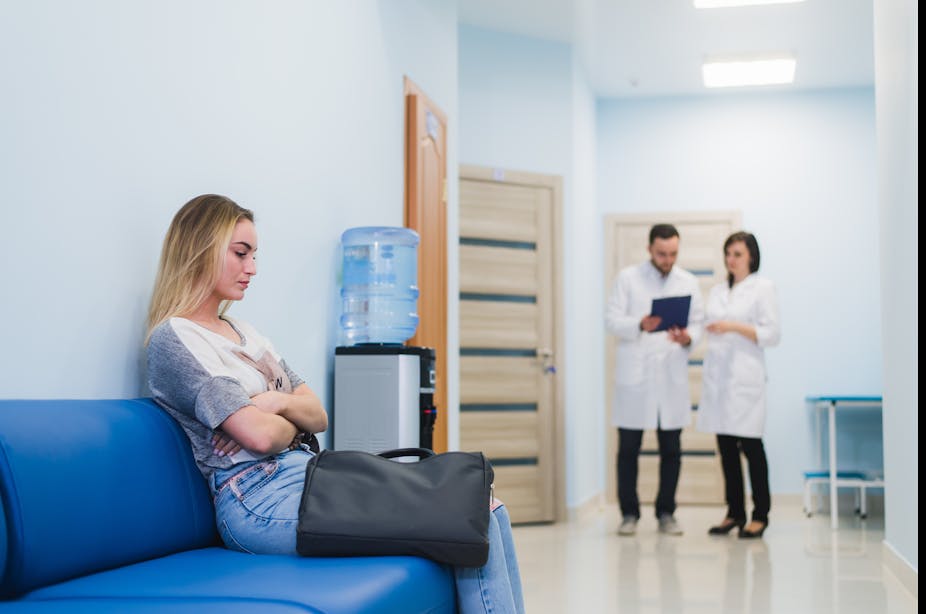Stigma and discrimination are common experiences that people who identify as LGBT or sexual minority face when accessing health services. One report found that one in seven LGBT people in the UK avoided seeking healthcare for fear of discrimination from staff. As many as one in four also experienced negative remarks against LGBT people from healthcare staff.
My colleagues and I recently conducted a systematic review which looked at the experiences of sexual minority women who had accessed UK health services. We defined “sexual minority” women as those who identified as lesbian or bisexual, women who have sex with other women, or live with or are married to another woman. This includes transgender women who identify as sexual minority as well as cisgender women.
We overwhelmingly found that women who identify as sexual minority experienced worse treatment in the healthcare system. We also found evidence that sexual minority women had worse health and well-being than heterosexual women, and tend to have worse health behaviours such as higher rates of smoking and drinking alcohol.
Barriers to healthcare
We looked at 26 studies conducted between 2010 and 2018. The size of these studies varied from extremely large (over a million respondents), to very small (such as a single lesbian response in a larger academic study). The health services that were accessed in these studies included general practice, cancer screening, midwifery, mental health, sexual health, dementia and hospice care.
Nine of the surveys we looked at showed sexual minority women had worse experiences than heterosexual women when accessing healthcare. Fewer sexual minority women had trust or confidence in their GP. They were also less likely to visit their GP than heterosexual women. Some also found their sexual orientation or their partner was ignored during appointments.
One large survey with 108,000 responses showed cisgender sexual minority women had widespread difficulties in accessing health services, particularly mental and sexual health services.
Similarly, another study showed that fewer sexual minority women were accessing cervical screening services than they should. Fewer than 50% had had a test in the previous three years. Some had even been told that they didn’t need a cervical screening test because they were lesbian, and others had been actively refused or discouraged by healthcare professionals from taking one.
However, some sexual minority women may be at more, rather than less, risk of cervical cancer than heterosexual women. Some bisexual women might be more likely to engage in risky heterosexual behaviour, such as having sex without contraception. There is also a higher rate of teenage pregnancy in sexual minority women.
Read more: How pregnancy can be made more difficult by maternity care's notions of 'normal'
We also found that many sexual minority women felt that health environments didn’t include them. Many were assumed to be heterosexual by healthcare practitioners. Others faced issues around whether to come out or not, and many received unhelpful responses from health professionals about being out.
There was also a general lack of LGBT-related images displayed in GP offices – such as same-sex couples on public health leaflets or information specific to sexual minorities. We even found reports of LGBT specific leaflets being actively removed from waiting areas. Official forms also didn’t include civil partnership status, despite it being legalised in 2013.
Some good practice was reported, but poor service was common, and came from a variety of healthcare staff including receptionists, nurses and doctors. We found there was general ignorance by healthcare staff of relevant issues, such as not being aware that HIV infection is rare in sexual minority women, and mistakes such as confusing the medical history of one partner in a same sex relationship with the other partner. Many also faced difficulties when challenging or complaining about the poor service they received.

Assumed heterosexuality and negative responses were described during cervical screening. Nurses typically asked about contraception, resulting either in the participant coming out during the procedure with risk of rejection, or incorrect assumptions being made. Women reported health professionals gasping, physically recoiling or giving inappropriate lectures. These negative experiences inevitably resulted in delayed attempts to access healthcare or being less able to receive a good quality service. Challenging and complaining were rarely reported for a variety of reasons, including the worry that it might lead to bad treatment.
There was also little information available about bisexual and transwomen’s issues in healthcare settings. Bisexual women often felt their bisexuality was invisible, and were assumed to be lesbian if in a same-sex relationship. In one study, a bisexual woman reported her counsellor actively denied her bisexuality and wanted her to realise she was heterosexual.
For lesbian and bisexual transwomen, a key issue was to be treated as a woman while receiving healthcare. In one report, a transwoman reported waking up on the male ward after surgery.
It’s clear that a lot of work still needs to be done within healthcare services to ensure that sexual minorities receive the care that they need. More explicit, consistent education by healthcare professionals on sexual minority issues is necessary, alongside stronger application of non-discrimination policies in clinical settings. Thankfully, programmes like the rainbow badge initiative are positive steps which aim to promote inclusion and education within the healthcare system, and provide proper support to sexual minorities.

